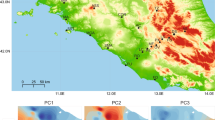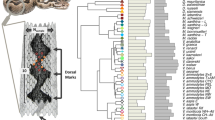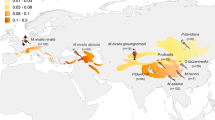Abstract
A cline in the frequency of melanic morphs of the two-spot ladybird, Adalia bipunctata, was first surveyed in 1980 along a transect extending inland from the coast in the Netherlands. At that time, the frequency of melanics increased over some 40 km from 10% near the coast to nearly 60% inland. Additional surveys made in 1991 and 1995 demonstrated some progressive change in cline shape. New samples from 1998 and 2004 confirm these dynamics, and show that over a period of about 50 generations for the beetle, the cline had decayed rapidly to yield rather uniform frequencies of melanic morphs at around 20% along the whole transect by 2004. Climate data and evidence for thermal melanism in this species support our contention that these dynamics reflect a dramatic example of a rapid genetic response within populations to climate change and local selection.
Similar content being viewed by others
Introduction
A variety of processes can enable organisms, including insects, to respond successfully to climate change (Stenseth et al., 2002; Bradshaw and Holzapfel, 2006; Parmesan, 2006). These include habitat tracking, phenotypic plasticity and genetic adaptation or some combination thereof. Evidence for the first of these mechanisms is becoming comparatively commonplace. Thus, many species of butterfly on the northern and southern edges of their range are clearly responding with northern extensions in their range limits (Parmesan and Yohe, 2003; see also Thomas et al., 2004; Hickling et al., 2006), and species of moth and other insects are moving up altitudinal gradients (Chen et al., 2009). The extent to which changes in phenotypic plasticity are (or will be) involved in the numerous reports of changes in phenology (Brakefield, 1987; Roy and Sparks, 2000; Amano et al., 2010) is not clear but in some case studies, including the timing of egg hatching in the winter moth and of egg laying in the great tit, there is already evidence that strong selection can occur on the characteristics of the underlying norms of reaction (Visser and Holleman, 2001; van Asch and Visser, 2007). There are as yet few reports of genetic changes within populations linked to climate change, including in insects. The pitcher plant mosquito, Wyeomyia smithii, showed a genetic response to climate change, which involved changes in sensitivity to photoperiod (Bradshaw et al., 2006). The change could be detected over a period as short as 5 years. On a wider geographic scale, changes in clines for the alcohol dehydrogenase polymorphism or in the frequencies of certain chromosome inversion polymorphisms have been detected in natural populations of species of Drosophila and linked to climate change (Umina et al., 2005; Balanyá et al., 2006).
Here, we report on the most recent data describing changes in a cline of melanism in the two-spot ladybird beetle, Adalia bipunctata L., along a transect that extends inland from the coast in the Netherlands. A steep cline when first surveyed in 1978–1981 (Brakefield, 1984a, 1984b) showed some progressive decay up until 1995 (de Jong and Brakefield, 1998). This was correlated with an increase in hours of spring sunshine and in spring temperatures. These data, when considered together with a variety of field and experimental data in support of the involvement of thermal melanism in this species (Brakefield, 1984b; de Jong et al., 1996), provided support for the change in the shape of the cline as reflecting a genetic response to climate change (de Jong and Brakefield, 1998). The documentation of further change in climate in the Netherlands since 1995 (see below) provided the impetus for us to continue monitoring the cline shape.
Materials and methods
Samples of A. bipunctata were collected in 1998 and in 2004 as adults or pupae from lime trees (Tilia spp.) and various shrubs and herbs from the same transect as that sampled in earlier years. Pupae were allowed to eclose in the laboratory, and then all samples scored for melanic morph (see Figure 1) in the same way as in previous studies (Brakefield, 1984a, 1984b; de Jong and Brakefield, 1998). Some information on sample sizes is included in Figure 1. The full data are available on request from the authors.
Changes over time in the proportion of the illustrated melanic and non-melanic morphs of the two-spot ladybird beetle along a transect of ca. 115 km in length in the Netherlands (bottom-left; source of map: http://www.lesidee.nl/). Samples were collected in each of the 5 years indicated at 16 more or less evenly spaced localities from west to east. Colouring of years matches the histograms for melanic frequency in the individual samples from each locality. Trend curves were fitted by eye with those for 1995 and 1998 overlapping inland. Localities are (1) Ouddorp; (2) Goedereede; (3) Stellendam; (4) Dirksland; (5) Middelharnis; (6) Oude Tonge; (7) Achthuizen; (8) Ooltgensplaat; (9) Willemstad; (10) Klundert; (11) Zevenbergen; (12) Etten-Leur; (13) Oudenbosch; (14) Prinsenbeek; (15) Tilburg; (16) Waalre/Eindhoven. The smallest number of beetles in an individual sample was 35, with an overall mean of 818 (s.e.=288 and median=152). The panel on the bottom-right shows deviations in average temperature from a ‘normal’ season/year at De Bilt (red spot on map). From left to right, columns represent data for winter (Wi; December–February), spring (Sp; March–May), summer (Su; June–August), autumn (Au; September–November) and the overall year (Tot), respectively, and from top to bottom for different years beginning before the period of ladybird sampling. The colour of each block indicates the extent to which the average temperature in the particular season/year deviated from ‘normal’; white=no deviation, blue=cooler than normal (dark blue more extreme than light blue), red=warmer than normal (dark red more extreme than light red). For further details and the source of this panel see: http://www.knmi.nl/cms/content/71542/.
The melanic polymorphism
The two-spot ladybird shows a number of genetically distinct colour morphs (Majerus, 1994). These morphs can be classified into two discrete classes, namely those that are predominantly black with red spots (melanics), and those that are red with black spots, usually one on each elytron (non-melanics; see Figure 1). A co-allelic series of alleles for melanism are genetically dominant to the recessive non-melanic, or typica, allele. The frequency of these morph classes varies geographically, and numerous examples of clines have been described in different countries (see Majerus, 1994). The geographical variation in morph frequencies in the Netherlands has been partly accounted for in field and laboratory studies by thermal melanism (de Jong et al., 1996). This hypothesis argues that the larger surface area of dorsal, black cuticle in the melanic morphs gives them a thermal advantage relative to non-melanics under conditions where activity is limited by the absorption of solar radiation (see de Jong et al., 1996 and references therein). Based on the results from laboratory experiments measuring the temperature profiles and activity of beetles of each morph under differing conditions of radiation, heating and convective cooling, melanic beetles are expected to have a thermal advantage over non-melanic beetles in the field whenever: (1) ambient temperatures are low; (2) the amount of wind is low; (3) sunshine is intermittent; and/or (4) the radiation intensity is high (de Jong et al., 1996). Thirty years ago, such conditions tended to occur in the east of the Netherlands away from the coast during the spring and early summer when ladybird beetles are emerging from hibernacula to feed on aphids and reproduce. Since that time, the climate inland at this time of the year has tended to become warmer with less cloud cover, and, thus, more similar to that along the coast (see de Jong and Brakefield, 1998).
Results and discussion
We collected new samples of A. bipunctata in 1998 and in 2004 along the same transect. Unfortunately, invasion of this region by an exotic Asian ladybird, Harmonia axyridis, from around 2002 onwards had by 2004 already produced a clear negative impact on the numbers and distribution of the endemic ladybird fauna, including A. bipunctata (see chapters in Roy and Wajnberg, 2008). This invasion has progressed dramatically until it is no longer possible to re-survey the transect by obtaining samples of sufficient size for detailed analysis. The 10 samples obtained in 2004 were also generally smaller than in each of the earlier surveys (mean=115 beetles; cf. Figure 1). In addition, we could not obtain any samples from five localities sampled in at least two of the previous surveys.
Figure 1 shows the results for 1998 and 2004, and compares these new data with the three previous surveys. A general linear model (GLM) analysis of the values for percentage melanics (Table 1; using ASIN-square root transformed yielding normally distributed data) with year as factor and distance from coast as a covariate gives a significant fit of year (F=8.03, P<0.0001) and distance (F=10.08, P<0.0001). Pairwise comparisons across years of the frequency of melanics in samples from each site (see Supplementary Table S1) show that at sites to the east of the transect, there are numerous examples of significant declines in melanism. In contrast near the coast, there are no declines and only a few significant increases at a single locality (Middelharnis). Figure 2a illustrates this pattern by showing how the changes over the study period are much more dramatic inland reflecting decreasing melanism. Clearly what was originally in 1980 a steep cline with a change in melanic frequency from around 10% to nearly 60% over some 40 km had decayed progressively to a pattern in 2004 of rather uniform melanism with a melanic frequency of around 20%. There was significant heterogeneity among the samples obtained in 2004 (heterogeneity χ2-test=25.86; df=9; P<0.01), but this is largely lost when the sample for the coastal site of Goedereede with only 8.6% melanics is excluded from analysis (χ2=8.26; df=8; P is NS; see Figure 2b). Assuming Hardy–Weinberg proportions, two alleles with the melanic allele dominant, a time span of 50 generations or two per year (Brakefield, 1984a, 1984b), a decline in melanic frequency from 55 to 20%, and constant (weak) selection, a rough estimate of the selection coefficient (s) can be calculated (Hartl, 1980) for the melanic disadvantage over the area to the east of locality 10 (see Figure 1). This calculation yields a selection coefficient of 0.036 to account for the evolutionary dynamics of the cline shape inland in the Netherlands.
Pattern of change in melanic frequency over time along the study transect. (a) Plotted in red: the maximum difference in percentage melanics between any two samples collected at each locality over the study period; and in yellow: the comparable difference for the earliest and latest samples obtained for each locality. A negative sign indicates a decline in melanism over time, and a star indicates a significant change in frequency. (b) The difference in each sampling year between the median value for percentage melanics for the five most westerly localities near the coast and that for the five most easterly localities inland showing the approach to homogenization over the whole transect.
The climate trends that we described in 1998 have continued in to the first decade of this century (Figure 1 and see http://www.cesar-database.nl) with average temperatures, especially in the spring, increasing inland (see also Visser and Holleman, 2001). The invasion by H. axyridis began at the very end of the sampling period around 2002 and is unlikely to have contributed to the evolution in cline shape even in the final period of sampling. Thus, although no direct test is available, our data are more likely to be explained by a genetic response to climate change working via the process of thermal melanism than by any other factor.
A cline of melanism in the peppered moth between urban Liverpool and rural North Wales has decayed dramatically under strong selection in recent decades (Saccheri et al., 2008 and references therein) as a region of high melanism in North-West England including Liverpool has almost disappeared (see also Majerus, 1998). This example has been explained at least in part by a change in visual predation as the effects of declining air pollution have affected the resting backgrounds of the moths in urban environments. Clines have not only been observed to decay rapidly but can also become established quickly, for example those involving chromosome inversions in colonizing populations of Drosophila subobscura presumably under the influence of local selection (Balanyá et al., 2006). The present study adds to potential examples of how some organisms are likely to be responding to climate change through direct genetic responses within populations. It will be necessary to understand such examples in detail to be able to assess properly the likely contribution of local adaptation and genetic responses in organisms to future climate change.
References
Amano T, Smithers RJ, Sparks TH, Sutherland WJ (2010). A 250-year index of first flowering dates and its response to temperature changes. Proc Roy Soc Lond B 277: 2451–2457.
Balanyá J, Oller JM, Huey RB, Gilchrist GW, Serra L (2006). Global genetic change tracks global climate warming in Drosophila subobscura. Science 313: 1773–1775.
Bradshaw WE, Holzapfel CM (2006). Climate change—evolutionary response to rapid climate change. Science 312: 1477–1478.
Bradshaw WE, Holzapfel CM, Mathias D (2006). Circadian rhythmicity and photoperiodism in the pitcher-plant mosquito: Can the seasonal timer evolve independently of the circadian clock? Am Nat 167: 601–605.
Brakefield PM (1984a). Ecological studies on the polymorphic ladybird Adalia bipunctata in The Netherlands. I. Population biology and geographical variation of melanism. J Anim Ecol 53: 761–774.
Brakefield PM (1984b). Ecological studies on the polymorphic ladybird Adalia bipunctata in the Netherlands. II. Population dynamics, differential timing of reproduction and thermal melanism. J Anim Ecol 53: 775–790.
Brakefield PM (1987). Geographical variability in, and temperature effects on, the phenology of Maniola jurtina and Pyronia tithonus in England and Wales. Ecol Entomol 12: 139–148.
Chen I-C, Shiu H-J, Benedick S, Holloway JD, Chey VK, Barlow HS et al. (2009). Elevation increases in moth assemblages over 42 years on a tropical mountain. Proc Natl Acad Sci USA 106: 1479–1483.
de Jong PW, Gussekloo SWS, Brakefield PM (1996). Differences in thermal balance, body temperature and activity between non-melanic and melanic two-spot ladybird beetles (Adalia bipunctata) under controlled conditions. J Exp Biol 199: 2655–2666.
de Jong PW, Brakefield PM (1998). Climate and change in clines for melanism in the two-spot ladybird, Adalia bipunctata (Coleoptera: Coccinellidae). Proc R Soc Lond B 265: 39–43.
Hartl DL (1980). Principles of Population Genetics. Sinauer Associates, Inc.: Massachusetts.
Hickling R, Roy DB, Hill JK, Fox R, Thomas CD (2006). The distributions of a wide range of taxonomic groups are expanding polewards. Glob Change Biol 12: 1–6.
Majerus MEN (1994). Ladybirds. Collins, London. New Naturalist series, nr. 81.
Majerus MEN (1998). Melanism: Evolution in Action,. Oxford University Press: Oxford.
Parmesan C (2006). Ecological and evolutionary responses to recent climate change. Annu Rev Ecol Evol Syst 37: 637–669.
Parmesan C, Yohe G (2003). A globally coherent fingerprint of climate change impacts across natural systems. Nature 421: 37–42.
Roy DB, Sparks TH (2000). Phenology of British butterflies and climate change. Glob Change Biol 6: 407–416.
Roy HE, Wajnberg E (eds). (2008). From Biological Control to Invasion: the Ladybird Harmonia axyridis as a Model Species. Springer: Netherlands.
Saccheri IJ, Rousset F, Watts PC, Brakefield PM, Cook LM (2008). Selection and gene flow on a diminishing cline of melanic peppered moths. Proc Natl Acad Sci USA 105: 16212–16217.
Stenseth NC, Mysterud A, Ottersen G, Hurrell JW, Chan KS, Lima M (2002). Ecological effects of climate fluctuations. Science 297: 1292–1296.
Thomas CD, Cameron A, Green RE, Bakkenes M, Beaumont LJ, Collingham YC et al. (2004). Extinction risk from climate change. Nature 427: 145–148.
Umina PA, Weeks AR, Kearney MR, McKechnie SW, Hoffmann AA (2005). A rapid shift in a classic clinal pattern in Drosophila reflecting climate change. Science 308: 691–693.
van Asch M, Visser ME (2007). Phenology of forest caterpillars and their host trees: the importance of synchrony. Ann Rev Entomol 52: 37–55.
Visser ME, Holleman LJM (2001). Warmer springs disrupt the synchrony of oak and winter moth phenology. Proc Roy Soc Lond B 268: 289–294.
Acknowledgements
We dedicate this paper to the late Michael Majerus whose great enthusiasm for ladybirds and for melanism did so much to stimulate a broad interest in natural history and evolution. We are grateful to the Royal Dutch Meteorological Institute (KNMI) for access via their web sites to meteorological records. We also thank Suzanne Lommen and Kees Koops for help with collecting, and two anonymous reviewers for valuable comments on the manuscript. This project was supported for the most recent survey by the Technology Foundation STW, applied science division of NWO and the technology programme of the Dutch Ministry of Economic Affairs.
Author information
Authors and Affiliations
Corresponding author
Ethics declarations
Competing interests
The authors declare no conflict of interest.
Additional information
Supplementary Information accompanies the paper on Heredity website
Supplementary information
Rights and permissions
About this article
Cite this article
Brakefield, P., de Jong, P. A steep cline in ladybird melanism has decayed over 25 years: a genetic response to climate change?. Heredity 107, 574–578 (2011). https://doi.org/10.1038/hdy.2011.49
Received:
Revised:
Accepted:
Published:
Issue Date:
DOI: https://doi.org/10.1038/hdy.2011.49
Keywords
This article is cited by
-
Drosophilids with darker cuticle have higher body temperature under light
Scientific Reports (2023)
-
Climate and body size have differential roles on melanism evolution across workers in a worldwide ant genus
Oecologia (2022)
-
Differential Bird Responses to Colour Morphs of an Aposematic Leaf Beetle may Affect Variation in Morph Frequencies in Polymorphic Prey Populations
Evolutionary Biology (2019)
-
A living mesoscopic cellular automaton made of skin scales
Nature (2017)
-
Genome‐wide population genetic analysis identifies evolutionary forces establishing continuous population divergence
Ecological Research (2017)





